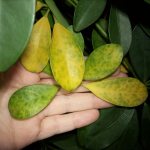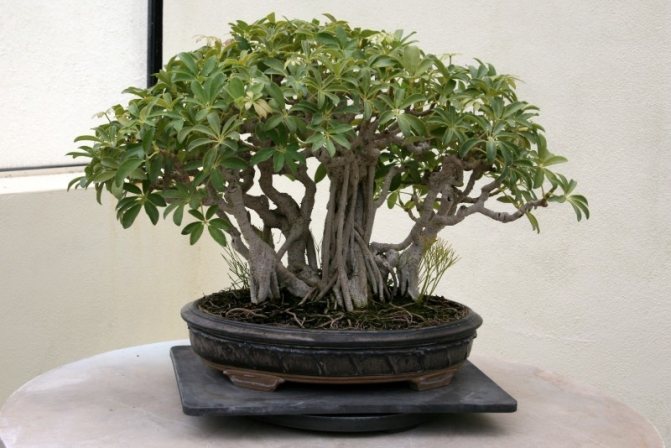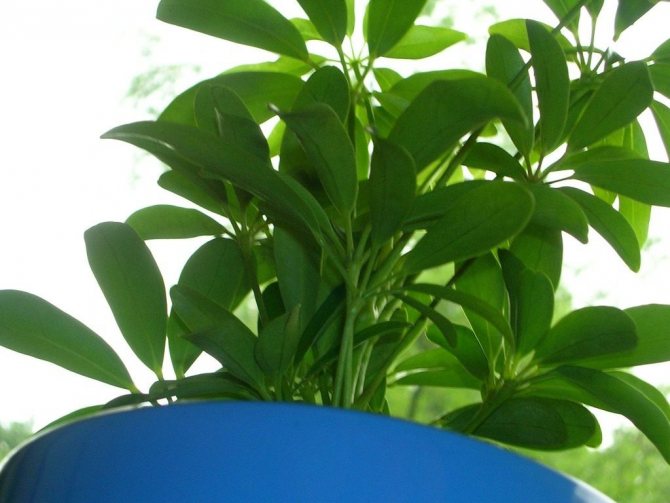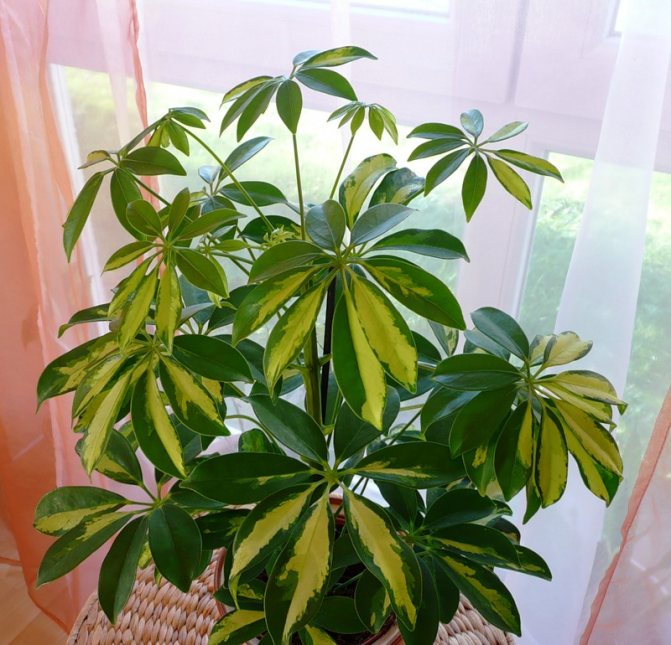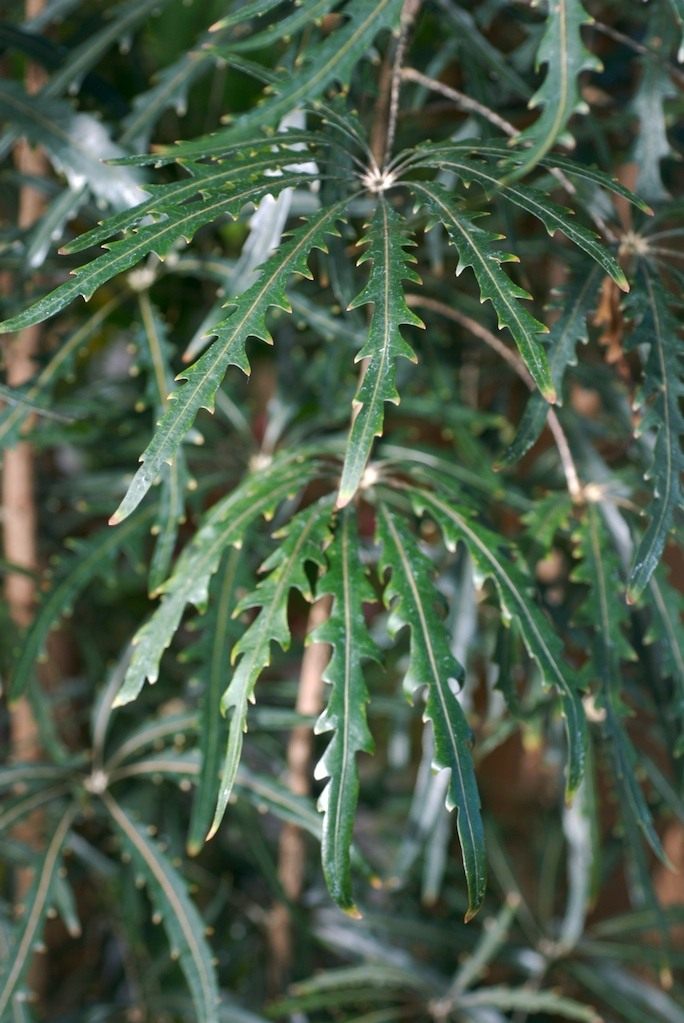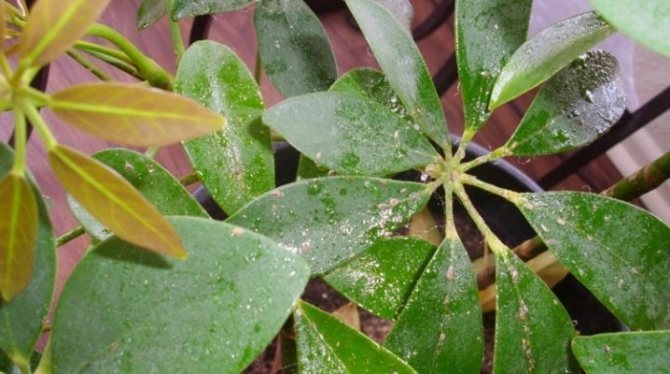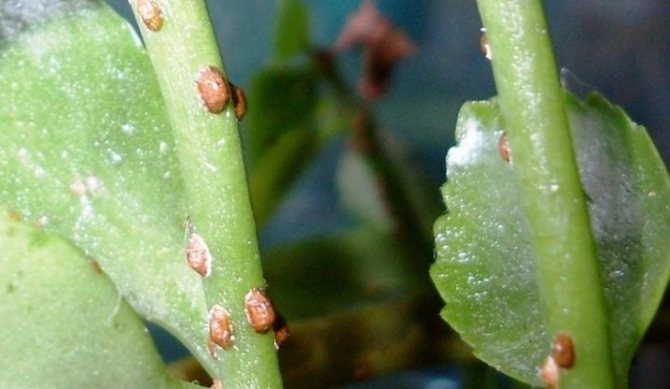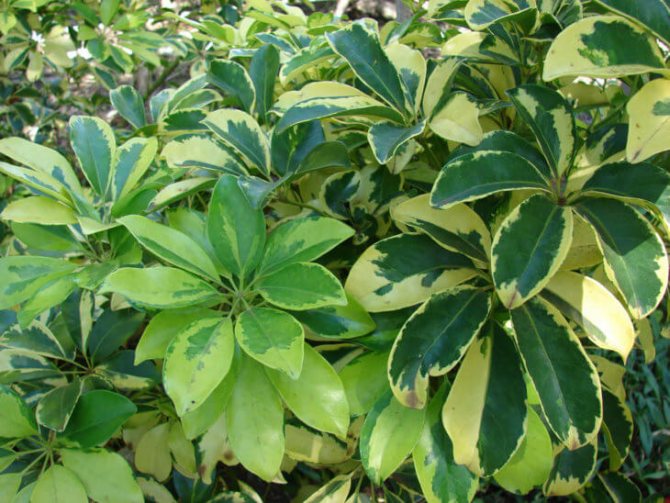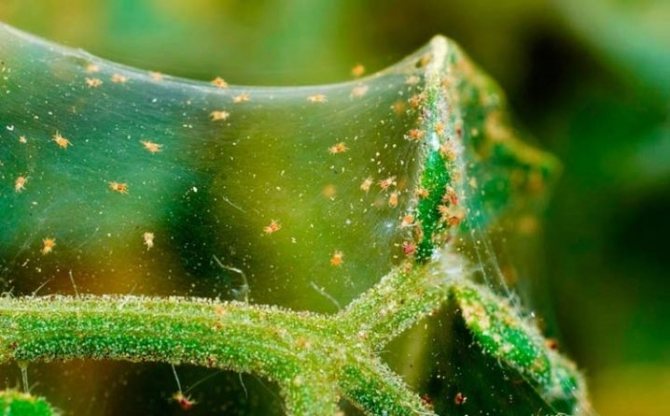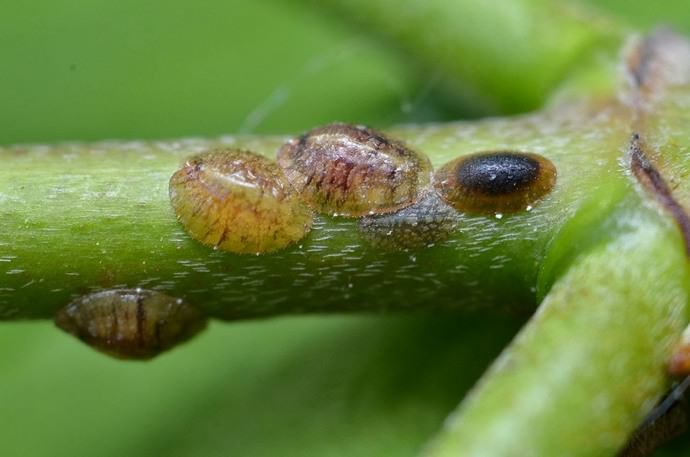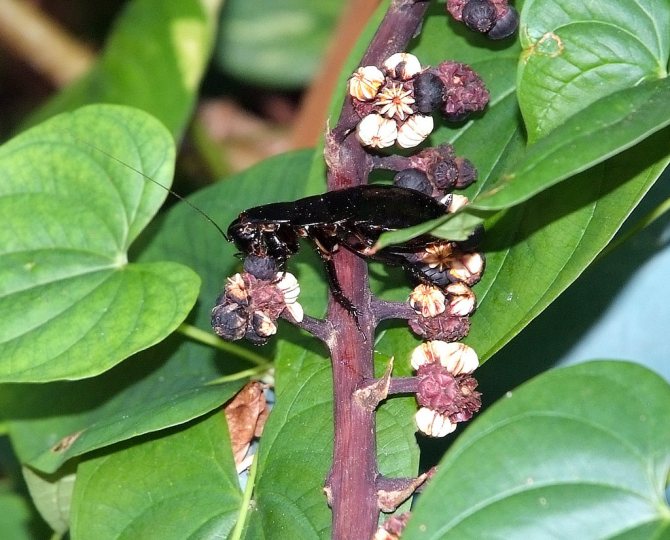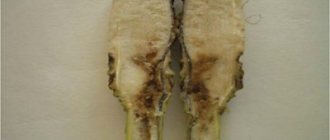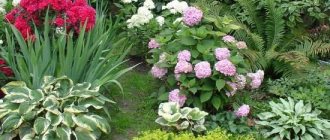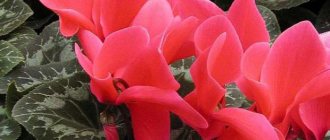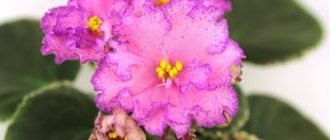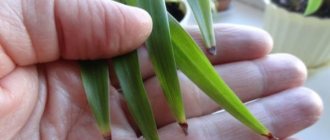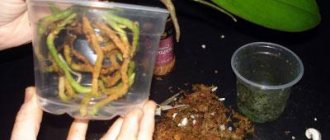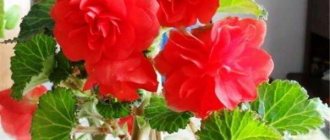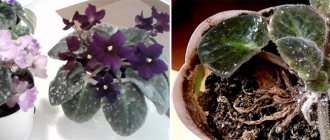Schefflera is not considered a capricious and demanding plant. Subject to the simple conditions of its cultivation, it pleases the grower with the lush beauty of its foliage. But often inexperienced lovers of exotic plants have problems taking care of it. Most often, this plant suddenly begins to shed its leaves.
If you do not take any measures, the sheffler may die. And here the most important thing is to establish the cause of leaf fall as soon as possible in order to save the plant and preserve its beauty. Consider the reasons why shefflera sheds leaves, and what to do.
Schefflera: problems with leaves at home
Turns yellow and sheds leaves
As a result of unfavorable conditions, Schefflera may get sick... In this case, the appearance of the flower becomes inconspicuous, the leaves turn yellow and begin to fall off.
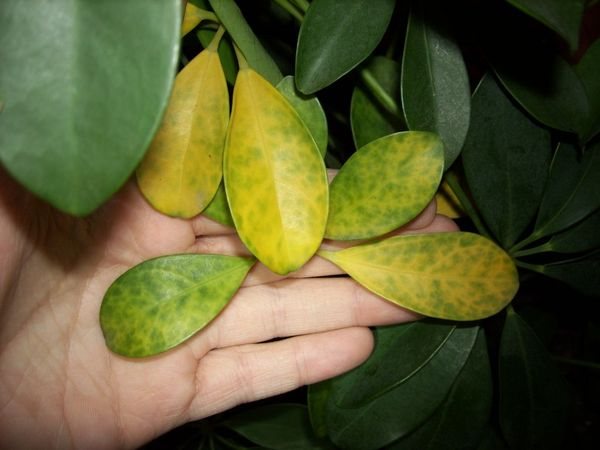
There are many reasons for the yellowing of the flower cover - from air temperature to overflow
The following factors can lead to this state:
- Low air temperature indoors - leads to the fact that the roots begin to rot, as a result of which the leaves turn yellow.
In this case, the flower is carefully removed from the pot, the rotten roots are cut off.
- High humidity soil - with abundant watering or improperly selected soil, dropping also occurs, the flower turns yellow.
In this case, it is necessary to stop watering for a while, and then water only when the soil dries out.
Spraying the flower should be done two to three times a day, depending on the humidity in the room.
- Capacity:
- Pot too big leads to the fact that the flower begins to turn yellow and shed both young and old leaves. In this case, a flower is removed from the pot, rotten roots are cut off. Sheflera is transplanted into a smaller container, placed under the greenhouse.
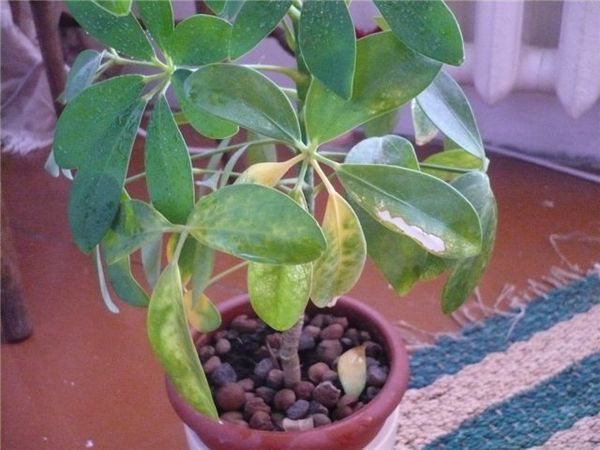

The selection of a pot is an important and difficult moment, since with a flowerpot of the wrong size, the pet begins to shed its cover
- Small pot can also lead to similar consequences. The roots become cramped in a small container, the roots tightly wrap around the walls of the pot, the plant turns yellow and sheds foliage.
In this case, you need to carefully remove the plant, trying not to disturb the earthen lump and transplant the flower into a more spacious pot.
It is impossible to violate the integrity of the earthen coma, since the pet reacts very painfully to this violation.
- Illumination plays an important role in the development and general condition of the flower. Poor lighting in the room leads to the shedding of leaves and yellowing of the flower. Lighting recommendations are as follows:
| Required light | Sheflera loves bright, sunny, diffused light |
| How to choose a window | Place on south-facing windows. Windows should be shaded so that there is no direct sunlight |
Throws off the leaves in the winter
In winter, it continues to develop, however, it needs to be provided with proper care.
The reasons that she throws off leaves in winter may be factors such as:
- Poor illumination premises - leads to the loss of leaves in the winter period of time, because in winter the daylight hours are short, and the cheflera likes bright, but slightly diffused light.
Therefore, you need to illuminate the flower with a lamp for several hours in the evening.
- Temperature regime - in winter, the temperature in the room drops and if the required temperature regime is not maintained with the help of heating devices, the same problem will happen. We described other recommendations for the microclimate in the paragraph on temperature and lighting for chefs at home.
- Dry air - do not keep near heaters or radiators. Such sources dry out the air, and it begins to lose its cover.
In winter, you need to spray the flower more often and keep it away from heating appliances.


The proximity of heating radiators leads to drying out of the air and illness of the pet
Leaves darken, turn black and fall
Darkening and subsequent dropping can be caused by the following reasons:
- Improper watering... If the flower is heavily flooded or watered with very cold tap water, this leads to the appearance that the foliage begins to darken / blacken and fall off.
It is necessary to immediately stop watering and wait until the soil is completely dry. Then watering must be resumed, but gradually, in order to avoid root rot.
- Drafts... Cold air and drafts can cause darkening and drying of the tips. In this case, it is urgent to move away from cold air and drafts.
- Bad air permeability of soil... It is necessary to loosen the topsoil as often as possible so that the root system can breathe. Can be transplanted into a lighter substrate.
The appearance of brown spots on the leaves
The most common disease of chefs is scabbard disease. This disease leads to the appearance of brown spots and subsequent blanching.
It is also advisable to increase the humidity in the room and spray more often... If the volume of infection is large, then the use of special drugs is necessary.
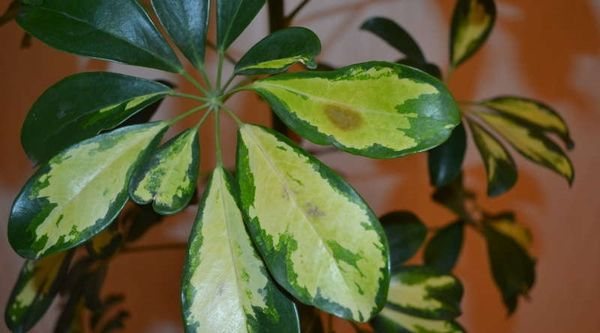

The reason for the appearance of such spots may be damage by a pest.
Why do the tips dry
There are many reasons why chefler tips begin to dry:
- Watering - do not water indoor plants with cold tap water. Such water contains a lot of chlorine and fluorine. These chemicals get into the roots. Then from the roots they fall into the leaves and burn them.
It is necessary to pour water from the tap into the container and defend it for at least a day. During this time, the chlorine will evaporate. And also the water temperature will be suitable for irrigation.
- Bay or overdry - if the plant is watered excessively, this leads to decay of the roots, and their decay gradually begins to turn into decay.
Dry soil leads to the fact that the tips of the leaves of the cheflera begin to dry.
There should be holes in the pot that will prevent water from stagnating and protect the root of the bush from decay.
- The appearance of pests - many different pests attack indoor flowers. If the flower is infected, the tips of the leaves begin to dry out.
- Air - if the air in the room is very dry, which can be caused by heating devices or climatic conditions, the tips begin to dry out.
Non-observance of the temperature regime and solution of the problem
Scheffler does not like too high and too low temperatures. The ideal range for its content is 20-22 ° C. It is not recommended to lower the temperature below 17 ° C, as the plant will feel bad. And with its further decrease, the sheffler will begin to shed leaves. Also, at low temperatures, there is a possibility of decay of the roots of the plant, which also very quickly affects its appearance.
Often the flower falls off in a draft, especially in a cold one. Such a sharp change in temperature is unusual for shefflera, which reacts to it with intense leaf fall.
The plant can hardly endure the summer heat. Temperatures above 25 ° C are also unacceptable for him.It can withstand a slight increase in temperature only under the condition of abundant watering and an increase in air humidity.
How to provide the plant with an acceptable temperature regime? It is not difficult in an apartment environment. In the summer, you need to remove the flower in the shade so that it does not overheat. In winter, the Schefflera feels great on a lighted windowsill. It is only necessary to remove it from the heating devices and from the opening window sashes.
Diseases of chefs and what to do with them
Some of the most common diseases are:
- The emergence brown and dark spots, which indicates excessive watering. If watering has been reduced, and the spots have not disappeared, you need to inspect the root system of the bush.
If the root has rotted, then do the following: the affected parts need to be treated with drugs such as "Fitosporin" or "Trichodermin".
- Lack of light leads to the fact that cheflera turns yellow... It is necessary to change the place and place the flower where there is more light and sun.
- Low air temperatures and drafts can damage the appearance of the cheflers, since the leaves will also dry up and turn yellow.
Tips & Tricks
Finally, I would like to share some useful recommendations, thanks to which it will be possible to preserve and maintain the health and beauty of your favorite flower.
- Many sheffler hobbyists start to worry about the fact that the young plant has too few leaves. But there is no need to worry, as this is quite normal for this type of home plant. As soon as the flower begins to mature, all the leaves will become the same size, and the plant will look beautiful.
- Sometimes growers are faced with such a problem when, as they grow, the leaves are formed at a great distance from each other, and the trunk of the plant is too elongated. Do not worry, as these are not signs of any disease. This suggests that the flower does not have enough light and is too hot. In this case, it is enough just to move the sheffler to more comfortable conditions for her, gradually the plant will become lush and healthy.


For information on how to properly transplant or plant Scheffler, see the video below.
Pests to which the flower is susceptible
The most dangerous for plants are pests. They are capable of infecting both the leaves and stem of the flower and the root system at home.
Often indoor plants, including the chefler, suffer from pests such as spider mites, aphids and scale insects... You can fight them by spraying with soapy water.
It is advisable to carry out such prophylaxis once a week. If the plant is already affected by a pest, spraying is done every day or several times a day.
In that case, if spraying doesn't help, it is necessary to use special preparations for pest control. These products are sold in any flower shop.
In the fight against flower pests, the drug "Karbofos" helps well. When processing with such a preparation, it is advisable to take the affected specimen to the street or balcony, since it has a very unpleasant odor.
If you follow the recommendations and provide timely care, you can grow a healthy and beautiful chefler. The main thing is to contain a flower in humid and warm climates... And with the help of the proposed tips, you can easily get rid of pests and heal the plant from diseases.
Houseplant Directory
Depending on the manifestations on the leaves - yellow, blacken, fall off - experienced florists identify problems with the sheflera. In today's article, we will consider why the leaves of the chefs turn black and fall. We will show you how to restore the plant.
What leaf problems indicate:
- The edges turn black, dry out → the air temperature is increased.
- The leaves turn black and fall → the chef is standing in a draft.
- Leaves turn black, but do not fall off → problems with moisture.
- Leaves are stained and stretched out → lack of fertilizer.
- Lower leaves rot, blacken → root system rot or temperature problems.
Diseases and pests - leaves fall
A reaction to external intervention, or to the development of a disease, may be a sharp drop of leaves. If the lower and middle leaves of the cheflers rot or change their color from green to yellow, so what is next - the black, it is possible that ticks, scale insects or other pests have been parasitizing them for a long time. It is difficult to detect them at an early stage, and then - it is enough to look under the leaf to see a whole colony of parasites.
How to remove parasites from sheets of chefs:
- Treat with soapy water.
- Disinfect with acaricide.
- Process until they leave.
- Cut off affected leaves.
- Treat remote areas.
It is not recommended to cut the leaves of the chefler if they have parasites - many leave their waste products, which cause the development of fungal diseases, or carry bacteria. When they get into a fresh wound, they cause diseases of the shoots, they enter the vascular system, spread throughout the plant - you can not save later. First, remove the parasites, then process, after which - restore the chefler with top dressing and suitable care.
Sheffler leaves turn yellow. Why? What to do?
A detailed explanation from experts why the leaves of the cheflera turn yellow. What to do with the sticky leaves of the cheflers? Photo, description of the problem and effective treatment.
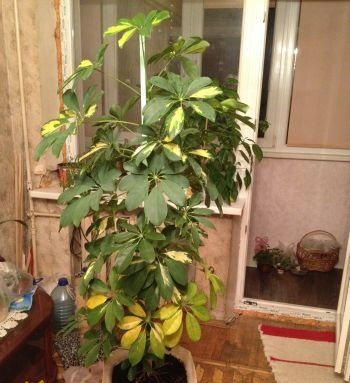

Shefler leaves turn yellow due to the natural cause of aging. In this case, we are talking about foliage, which is about three years old and it is located in the lower part of the plant. Experts do not see a problem in the fact that the lower leaves of the chefs turn yellow, if this happens in the fall and is not massive. However, you need to pay attention to the conditions for keeping the flower. If they did not change and the flower previously felt normal, and then began to lose the lower leaves, then this should not cause confusion. If the conditions for keeping the plant changed for the worse (low level of illumination, waterlogging of the soil) and the chefs began to turn yellow, the leaves crumble, then it is necessary to provide the flower with normal care.
Why does the cheflera shed leaves? In conditions of low temperature and high humidity of the soil, the shefler often sheds leaves. It can be both old and young foliage. Waterlogging of the soil can occur due to abundant watering, improper soil (with increased moisture capacity). The plant may be planted in an oversized pot. What to do? From an excess of moisture and low temperature in the room, the chefs rot the roots. The affected flower must be removed from the pot and the roots must be examined. Raised trim. Plant a flower in a smaller pot, place it under a greenhouse. Wait a little with watering, water when the soil is completely dry, and spray often (2-3 times a day). The temperature of the flower content should not be lower than +20. +22 degrees.
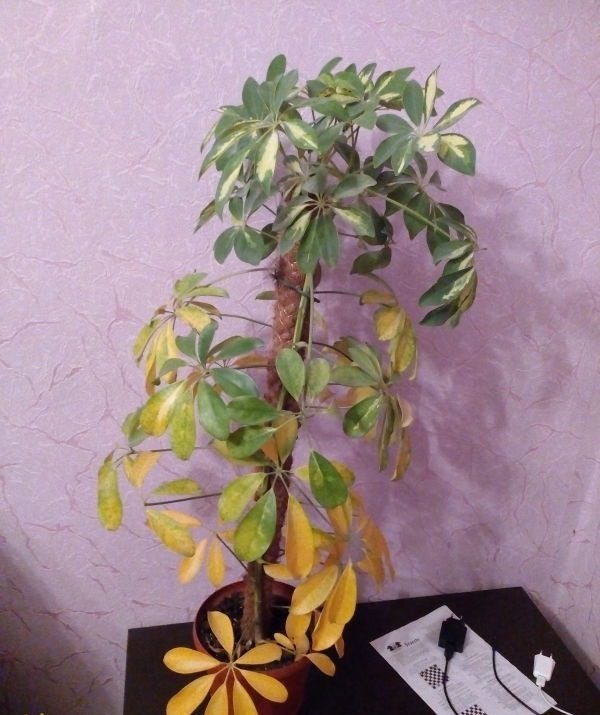

Why do the chef's leaves turn yellow if the watering regime is correct? One of the reasons is lack of nutrients or the roots are too crowded in the pot. In this case, you need to remove the flower from the pot without violating the integrity of the earthen coma. If the roots are tightly wrapped around the walls of the pot, transplant is performed by transshipment. But the integrity of the earthen coma cannot be violated. Sheflera reacts very painfully to this.


The chief falls. What to do? Often, the leaves of the chefs turn yellow and fall off after a change in the conditions of detention. For example, a newly purchased plant was moved to a new place of residence, that is, to the owner's apartment or house. Often in a new place, there is a different level of air humidity, illumination and temperature. Shedding leaves is a reaction to changing conditions.After purchase, the plant must adapt to the new place of residence, and therefore it is not recommended to transplant or feed it for 1 month (the period does not have a clear framework). The plant successfully survived the adaptation period when the leaf fall stopped and new foliage began to grow. In order for the adaptation period to pass faster and the cheflera no longer shed leaves, she needs a bright, diffused light. In winter, the flower must be provided with artificial lighting for at least 12 hours a day. Cycron (1 drop per 200 ml of water) can be added to the water for irrigation to maintain the root system. Epin (2 drops per 200 ml of water) is added to the water for spraying. Water the flower abundantly, but only after the soil has dried. Spraying is carried out at least 2 times a day. But it all depends on the temperature of the content. The higher it is, the more often you need to spray the chefler. In summer, the optimum temperature of the content is +20. +25, in winter (forced rest period) - the optimum temperature is +14. +20 degrees.


One of the reasons why the shefler falls off may be the wrong transplant. So, the plant has a very delicate root system, which should not be disturbed unnecessarily. If the flower transplant was carried out with a complete replacement of the soil, that is, the chefler was taken out of the pot, the earthen lump that surrounded the roots was destroyed, and moved to a new soil, then the flower will shed its leaves. During transplantation with a complete soil replacement, small roots (capillaries) are damaged, which are involved in the process of water consumption and flower nutrition. Without small roots, the plant begins to starve and is unable to drink water. Over time, the root system should recover, but first the plant will hurt. What to do if the chef falls? To shorten the recovery process as much as possible, the chefs need to add a cyclone to the water for irrigation, and epin to the water for spraying. The flower is rarely watered, only after the soil has completely dried, it is sprayed, on the contrary, often (several times a day). A good level of light is required, but not direct sunlight. The temperature of the content is within +20. +22 degrees.
Improper watering
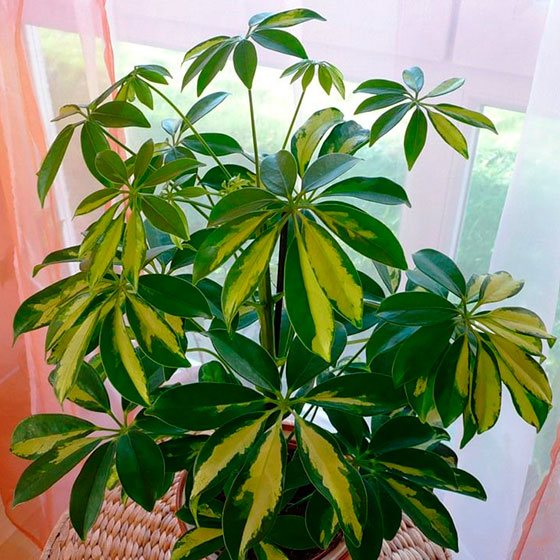

Exactly the same situation can occur with improper watering, namely, with an excess of moisture in the soil. In this case, the soil in the pot turns into a kind of swamp, where harmful bacteria quickly activate their vital activity. Under their influence, the roots get sick, the leaves turn black, the plant becomes bare. In addition, with an excess of moisture in the soil, oxygen deficiency is observed, in which the plant simply suffocates.
If you have allowed such a mini-waterlogging of the soil, it is better to replace it completely. Before transplanting, the chefs remove all rotten and dead roots from its root system. After that, dry the roots, and only then immerse them in new soil. After such an emergency transplant, do not water the flower for several days.


The chefler tolerates a lack of water in the soil more persistently than its excess. However, if the drought continues for several days, the leaves on this plant begin to behave as if there is excess moisture. Dark spots appear on their surface, then the leaves turn yellow, die off. In such a situation, arrange watering according to the recommendations for this plant.
Sheflera sheds leaves with an excess of mineral fertilizers in the soil. An excess of nitrogen is especially dangerous for the root system. It causes root burns.
Causes - general information
So, at home, a chefler can turn yellow and shed foliage for the following reasons:
- too low air temperature;
- waterlogging;
- improperly selected pot;
- root damage during transplantation;
- poor lighting;
- illness;
- damage by pests;
- adaptation;
- dry air;
- malnutrition;
Further, we will consider all the above reasons in more detail, we will find out why they arise, how to deal with the problem that has arisen in each specific case.
Popular types
Tree-like
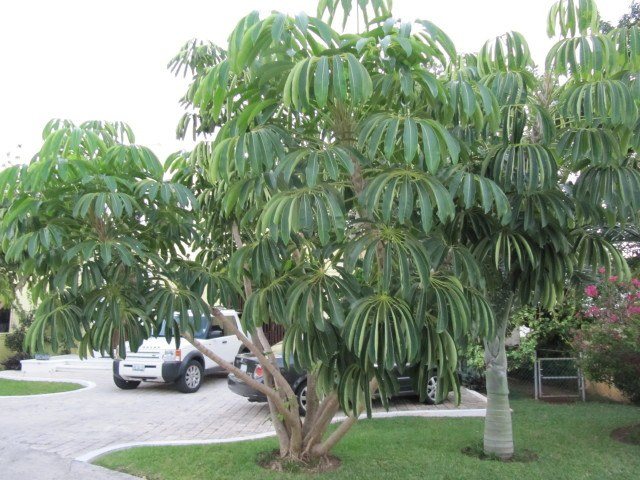

An evergreen shrub that grows up to 4 m under natural conditions.The leaves are palmate, the width of the leaf blades is up to 10 cm, the length is up to 20 cm.
Gerda
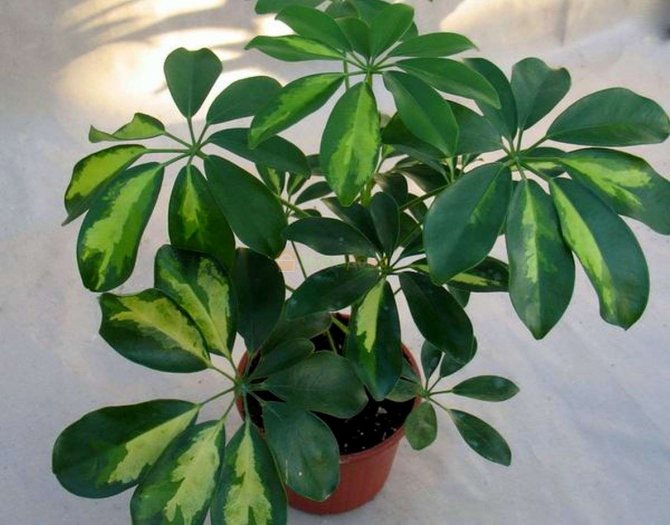

Schefflera variegated Gerda
The representative of the Scheffler species is tree-like, its foliage is a bright yellow-green or white-green hue, similar to an open rosette. It reaches a height of 2.5 m, it is unpretentious in care.


Compact appearance, leaf blades are divided and slightly rounded, dark green shade, undemanding in home care.
Janine
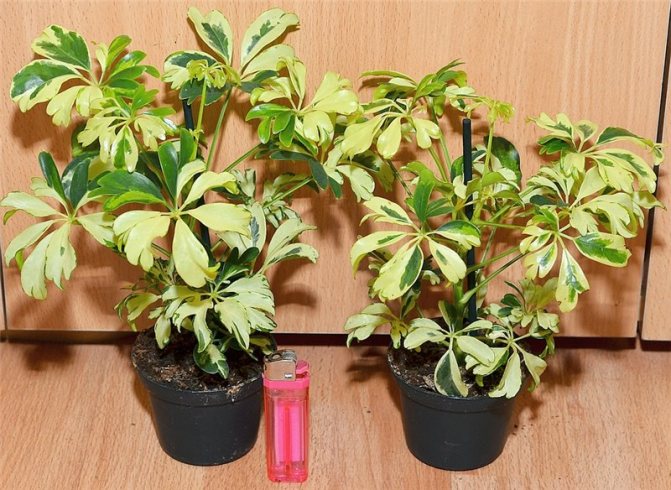

It is characterized by elegant foliage of a light olive shade with yellow splashes, a lush crown.
Bianca
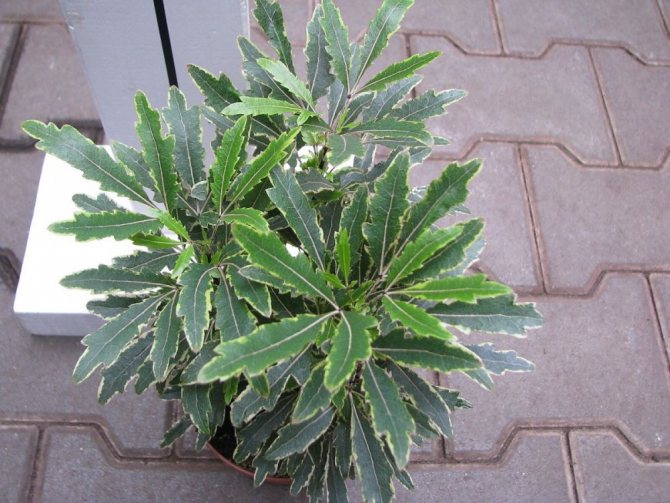

Differs in spectacular leaves, which are covered with a pattern. The leaf blades reach 8 cm in length, they have a white edging at the edges, and beige at the base.
Arboricola
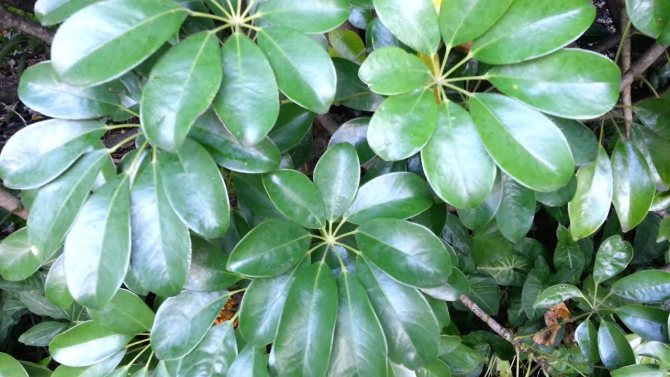

The leaf plates are characterized by a white or golden mottled hue. Reaches 120 cm in height, branches well. There are green and variegated varieties. Mature plants need to be pruned.
Radiant


Under natural conditions, it grows up to 15 m, at home - up to 2.5 m.The stem of the plant is light brown, on red-brown petioles there are large and shiny leaf plates of a bright green shade up to 60 cm long.
Louisiana
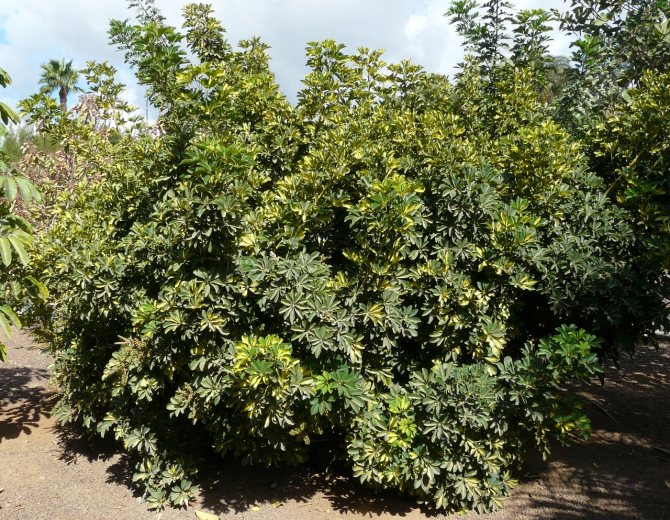

Undemanding in care, leaf plates are decorative, variegated, openwork, leathery, shiny.
Melanie
The plant is unpretentious, the leaf plates are painted in various shades of green, the crown looks very elegant.
The reason is the temperature
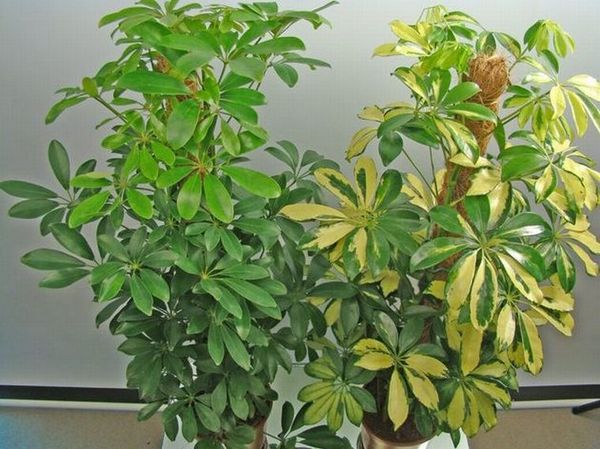

As a result of exposure to insufficiently high air temperature, shefflers often begin to rot the roots. The condition as a whole is dangerous for the plant, and one of its symptoms is yellowing of the foliage, its falling off. If the rot has spread, the shoots of the flower darken.
For normal life, the plant needs a temperature of about + 18-22 degrees. A lower temperature regime is permissible only for a very short time: if the cold snap is prolonged, the sheffler will not be slow to react negatively to it.
What to do
If the cause of the yellowing is precisely the rotting of the roots, you cannot hesitate, urgent measures should be taken. The sheffler will have to get out of the pot to inspect the root system. Trim off all decayed areas down to white, healthy tissue. Then you need to treat the surviving roots with an antiseptic-fungicide. After processing, the sheffler is transplanted into fresh soil: if an old pot is used, it must first be disinfected.
You should not expose the flower to drafts: under sudden gusts of cold wind, the sheffler leaves can be thrown off with a high probability.
Note that this plant also does not like excessive heat - average temperature indicators are optimal. If we are talking about summer, when the heat is inevitable, ease the condition of the plant by spraying and watering it more often, and moving the pot from the windowsill to the shade. Keep away from radiators in winter.
Foliage falling - what to do?
- The most common reason why a chefler may start throwing off leaves is violation of the temperature regime... If this happens in the summer, then most likely the plant is too hot. Move it to a cooler place and increase hydration. In winter, during the dormant period, the bush needs a temperature not lower than +12 ° C. With a large volume of losses, but a living trunk, the flower will be saved by transplanting into a fresh substrate with simultaneous pruning of dry branches and processing the sections with crushed coal.
- Foliage on a tree can fall off at a difficult stage. excessive moisture and root rot lesions. Low air temperature aggravates the consequences of overflow.Resuscitation of the plant will consist of several stages: removal of the decayed part of the roots, keeping for 2 hours in a solution of any biostimulant, treatment of the root system with a fungicizing solution and, finally, transplanting into a disinfected pot with new nutrient soil. After transplanting, it is good to create greenhouse conditions for the chef for a couple of days, placing it under polyethylene and periodically airing it.
- Often, foliage can lead to too dry air... At the first loss, immediately increase the spraying and eliminate possible sources of air drying. For example, in winter it can be heaters or heating radiators, in summer - a southern window, from which the plant should be moved as far as possible.
Root damage


Sometimes, with careless handling during the next or unscheduled transplant, the roots of the plant are damaged. Scheffler reacts extremely painfully to injury to his roots. If the damage is severe, the flower not only turns yellow and sheds foliage, but may die.
What to do
When transplanting, the plant should be handled very carefully. Carry out the procedure only by the transshipment method while preserving the old earthen clod. Trying to get rid of old soil, you should not peel it off the roots. Such handling is likely to result in root breakage.
Tip: if the roots were still touched, after transplanting, water the plant with a solution of Epin or Zircon. These drugs promote root formation, restore immunity.
Description
Shefflers are home to Japan, China, East Asia, Taiwan, Australia, Vietnam. In nature, it grows in tropical forests in regions with a humid and hot climate.
It is an evergreen plant with glossy, finger-like leaves of a dark green hue, which sit on long petioles. Shefflers' leaf blades diverge from one point, like the needles of an umbrella, because of this it is called "a flower with green palms."
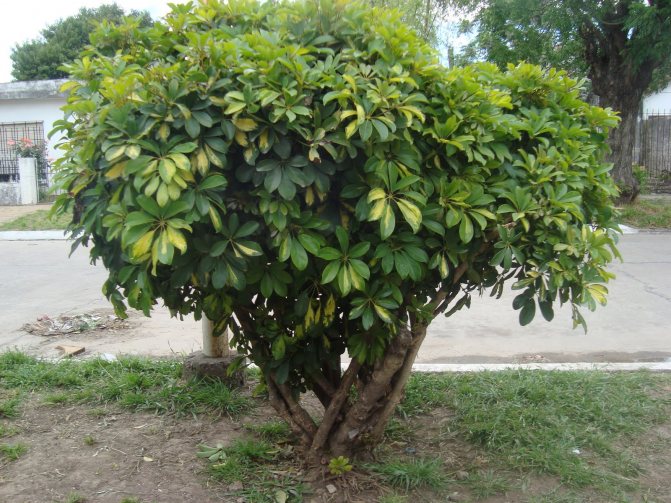

Lack of light
Schefflera is a southern flower, and abundant lighting is necessary for her to feel normal. Often it is the lack of light that leads to unpleasant problems in the form of yellowing of the leaves, their falling off.
What to do
Abundant but diffused light is required. It is best to place the plant on the south side of the apartment, shading from the midday sun. If the windows are north, take care of additional illumination from artificial lamps.
Additional lighting is required for a flower in winter, regardless of which window it is on. In winter, in our area it gets dark early anyway, and a Scheffler needs at least 12 hours of daylight for normal health.
How to get rid of the scale insect (video)
Also, according to the observations of experienced flower growers, an excess of sunlight often leads to the appearance of ugly light spots on the foliage, and insufficient lighting is the most important reason for the tarnishing of the aboveground part of the variegated sheffler. Strict adherence to the regime of correct irrigation measures, ensuring optimal illumination, as well as a comfortable level of temperature and humidity, allows the decorative culture to grow normally and preserve its decorative effect, regardless of the age of the plant or the stage of vegetation.
Diseases
Sometimes foliage can turn yellow and fall off due to a disease. Most often, fungal and putrefactive pathologies lead to the problem.
What to do
Out of the blue, the disease usually does not occur. As a rule, it is caused by illiterate agricultural technology and non-observance of the rules of care. To prevent diseases, it is necessary to carry out competent and timely care for the shefflera.
Tip: if the disease has led to root rot, treat the lower part of the plant after pruning the affected parts with drugs such as Trichodermin or Fitosporin.
Some tips for caring for your boss
In order for the chef to develop well in room conditions, she needs to provide the necessary parameters and pay a little attention. To facilitate care, experienced florists advise:
- To prevent waterlogging of the soil, water the flower through pallets.
- Do not place the flowerpot near radiators so as not to overheat the plant.
- Diffuse bright sunlight with special nets and glass stickers.
- Use prolonged exposure granules as top dressing.
- Regularly carry out preventive treatment against pests and diseases.
- When planting, use special ready-made soil mixtures.
Timely care of the sheflera promotes the rapid growth of the plant and significantly reduces the risk of infection with harmful insects and diseases.
While watching the video, you will learn about growing chefs.
Pests


Schefflera, unfortunately, is quite susceptible to damage by harmful insects. Especially often, the content of the flower in conditions of increased dry air leads to a similar problem. Insects, settling on a plant, infect its tissues, penetrate the roots, eat the vegetative, green part. More often than others, the following insects affect the sheffler: scale insects, aphids, spider mites.
What to do
To control the appearance of pests, regularly inspect the flower for their detection. If insects are seen, treat the plant twice with soapy water. With a weak, initial stage of the lesion, this measure is usually sufficient.
But if the pests have spread, the soap solution may not help: use insecticides in this case. The drug Karbofos, which copes with the main types of pests of domestic plants, has proven itself quite well. Carry out the treatment on the balcony, veranda, since the pungent smell and suspension of the drug in the air are dangerous to households and animals.
The appearance of dark spots - what to do?
- Often, the appearance of black spots on the leaves is the first symptom that you pour or water the chefler with too cold water. In this case, you should immediately stop watering and wait until the earthen coma is completely dry. Then moistening can be started again, but this should be done gradually and very moderately, otherwise the plant will begin to rot the roots, it will shed the foliage and a transplant will be required.
- If the edges of the leaves have darkened and dried up on the flower, this indicates that the bush is standing in a draft. It is urgently required to move it to a more secluded place, away from cold air currents.
- Insufficient air permeability of the soil can lead to the appearance of dark spots. Do not forget to regularly loosen the topsoil or transplant the flower into a lighter substrate.
- Sometimes the loss of decorative foliage occurs due to pest damage.
For example, yellowing and curvature of leaf plates may indicate the presence of a mealybug, which develops at low air humidity. For healing, the flower must be treated with soapy water, and then with warm water.
The appearance of brown spots and the blanching of the foliage is due to the defeat of the scabbard. To combat it, multiple processing of the sheet plates with alcohol or soap solution will be required. In addition, the humidity should be increased by more frequent spraying.
With large volumes of infection, it is better to resort to special drugs, for example, such as actellic or karbofos.
Adaptation
Schefflera is a real conservative and can react extremely negatively to a change of residence, even to a simple rearrangement of the pot. Sometimes the adaptation is delayed and leads to yellowing, and even falling off the leaves.
What to do
After buying a plant, you should not immediately begin to actively water it, fertilize it and put it in direct sunlight on the window.Give the flower time to get used to it: for this you need to place it in a semi-dark place, water it moderately and do not fertilize until it is fully adapted. When you see that the sheffler has stopped shedding the leaves and has begun to release new shoots, leaves, you can put it in its permanent place and begin standard care procedures.
Knowing the plant's dislike for change, try not to touch it again. Before you buy a flower, think in advance about the place where it will be located. And afterwards try not to change this place without special need. If the shefflera is very "nervous", experiencing stress, calm her down by sprinkling with Epin solution.
Content requirements
The flower does not cause serious care problems, however, it requires knowledge of some of the features characteristic of many tropical plants:
- the need for high air humidity, which is achieved by daily spraying even in winter;
- dislike for sudden changes in temperature and drafts (optimal range - from +16 to +22 ° C);
- negative reaction to both excessive waterlogging and overdrying of the earthy coma;
- good illumination without direct sun;
- light breathable soil and good drainage;
- moderate watering with warm, settled or melt water is preferable.
If one or more of the above conditions are violated, the plant immediately reacts by darkening or falling leaves. Let's consider each of the reasons in more detail.
Dry air
Dry air is a common thing in a standard city apartment. It dries naturally in summer due to the heat outside the window, in winter due to working batteries. For the sheffler, such conditions are not the most favorable: due to the dry air, its leaves curl, wither and fall, and it is also likely to be damaged by pests.
What to do
Dry air must be fought. This will benefit not only the chefler and other indoor plants, but also the household members themselves. The easiest and most affordable way to maintain an optimal microclimate is to spray a flower from a spray bottle. In winter, when the batteries are running, and in summer, in hot weather, we recommend spraying once or twice a day; in cool and relatively humid conditions, spray less often: once or twice a week.
Also, to maintain an optimal microclimate, you can put a pot with a plant on a pallet with wet expanded clay pebbles, pebbles, sand. Well, the most modern and useful option is to purchase a special air humidifier.
Why do Calathea leaves dry and how to save the plant
Good results are obtained by keeping the shefflera in a deep pan with a moistened substrate. You can fill the container with expanded clay, coarse sand or pebbles. The substrate should not be wet, so that additional moistening of the soil in the pot does not occur. Sometimes special air humidifiers are also used.
All these methods provide the plant with comfortable growth conditions. In a humid atmosphere, the shcheffler has a very lush and decorative appearance, its leaves do not fall off for a long time.
Lack of nutrition


If the sheffler is lacking in nutrients, she will respond by getting rid of the foliage. Thus, the flower will try to save reserves of minerals.
What to do
It is unacceptable to keep the plant for a long time in poor soil, devoid of nutrients. If the shefflera not only turns yellow, but has already begun to get rid of the foliage, then the circumstances have taken a serious turn. Apply top dressing urgently, make sure that the fertilizer contains nitrogen. This mineral is responsible for the vegetative part of the plant, therefore it will help to quickly restore green mass.
Try to avoid an oversupply of fertilizers: this will not lead to anything good either. The plant should be fertilized only during the active growing season: that is, in spring-summer, and very moderately. In winter and during the adaptation period, the chef does not need feeding,
We found out why the leaves of the chefs fall and turn yellow. As you can see, there are enough reasons: it is important to find out the specific in each individual case, and it is with her to fight. Correct and accurate diagnosis is the key to a quick and successful solution to the problem.
Scheffler video
Schefflera is not considered a capricious and demanding plant. Subject to the simple conditions of its cultivation, it pleases the grower with the lush beauty of its foliage. But often inexperienced lovers of exotic plants have problems with caring for it. Most often, this plant suddenly begins to shed its leaves.
If you do not take any measures, the sheffler may die. And here the most important thing is to establish the cause of the leaf fall as soon as possible in order to save the plant and preserve its beauty. Consider the reasons why the shefflera sheds leaves, and what to do.
General troubleshooting tips
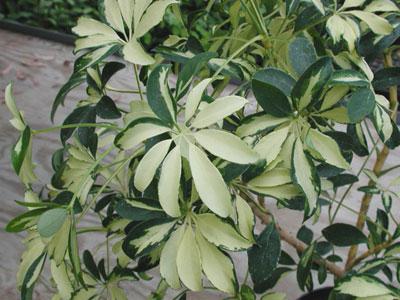

So, whatever the reasons for the leaves falling off, all of them must be eliminated. It is important to pay attention to the plant more often: it shows by its appearance what kind of problems have arisen. Simple measures can quickly restore the health and decorative effect of a plant called a chefler at home. Caring for the boss, if properly carried out, will protect the culture from diseases, and the owner from unnecessary worries.
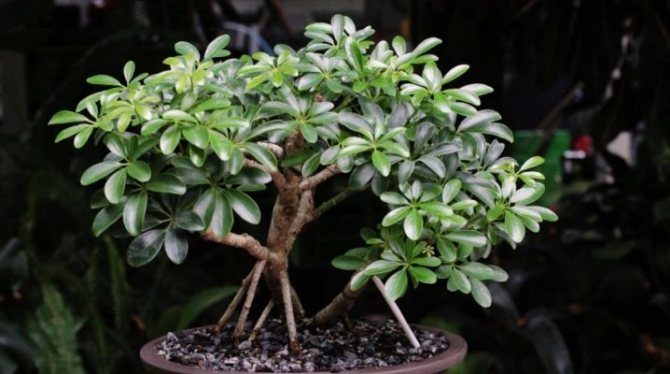

Inhabitant of tropical forests, Schefflera is an evergreen shrub, the decorative effect of which is in the variegated color and unusual shape of its leaves. The plant has taken root well at home and has become a favorite of flower growers.
Waterlogging
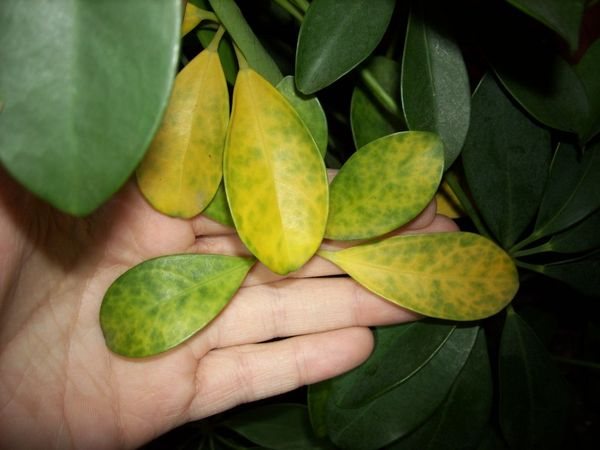

If the sheffler is regularly poured, allowing stagnation of moisture in the soil, over time the plant will react to this dropping of foliage and its yellowing.
What to do
It is necessary to stop watering the flower for a while until its condition returns to normal. In severe cases, when root decay has begun, the sheffler will have to be transplanted.
Lighting, humidity and moderate watering are three important criteria
Correctly chosen lighting is another main rule when caring for a cheflera. The best lighting for the plant is intense, but diffused light, because direct sunlight can burn the leaves. A flower with variegated leaves requires a little more light. But varieties with greens can be grown on the north side. In the winter season, it is better to put the plant in the most lighted place and, if necessary, use ordinary fluorescent lamps.


Sheflera, home care. Photo
Caring for the chefleur includes another essential point - the humidity in the room. Spray the chefler at home at least twice a day, and even more often in winter, since the plant needs high humidity.
It is recommended to stand the water before watering. Do not overfill the sheffler, otherwise this will be the reason why the leaves of the sheffler fall. She categorically does not tolerate frequent and excessive watering, this can lead to the fact that the roots begin to rot. Wait for the soil from the previous watering to dry out, but do not let the soil dry out completely.
Pertinent advice: pour expanded clay or wet sand into the pallet where the pot with the plant stands. In the summer, the right solution would be to wipe its leaves with a slightly damp cloth or sponge.
With such a caring care of the chef, she will delight you with her leaves from year to year.
How to care for a plant
All varieties require special care. They prefer diffused light, humid air, and abundant watering.
Attention!
Shoots feel better on the sill of a west-facing window.
Sheflera loves to swim. To make its leaves shine, they must be regularly sprayed. In the summer, the plant is watered frequently and abundantly, using water at room temperature. In winter, watering should be moderate.
To form a crown, you need to prune. This is done in the spring, on the new moon, when the plants are actively growing.To give the shape of a ball, the top of the plant is cut off. It will release side shoots, which are then pinched so that the crown is thick and beautiful.
For a pyramidal shape, the tops of the side branches are cut off. After pinching the tops, the plant is abundantly watered and fed.
Shefler is fertilized with a universal mixture designed for indoor plants. During active growth, this is done after 2 weeks, starting in February. From October to January, the flower is dormant. During this period, he does not need food.
Bacteria
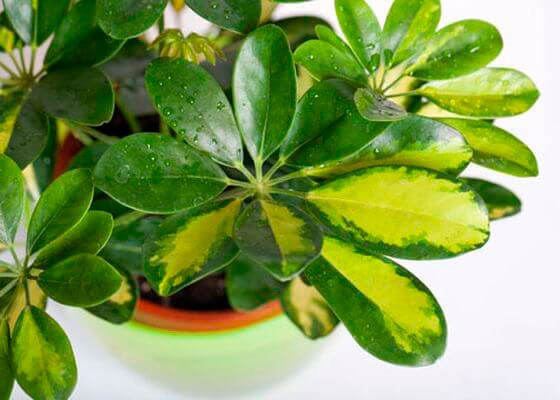

Darkening and leaf fall can occur due to the presence of fungal or pathogenic bacteria in the soil. They can appear there if, when transplanting, the chefs were too lazy to process the soil with a weak solution of manganese. If you find that the leaves have begun to turn yellow, try treating the soil with a fungicide.
If this simple procedure turns out to be ineffective, then transplant the plant into new soil, which you prepare according to all the rules.
Plant conditions
Given that all indoor cheflers descended from tropical plants, special attention should be paid when growing them to such points as:
- temperature
- humidity and watering regime
- lighting
- the soil
Temperature
The room where the plant stands should be warm in summer and moderately cool in winter. In the spring-summer season, the temperature regime must be maintained at + 20 + 24 degrees. It is desirable that the night temperature is 2-3 degrees lower than the daytime.
In winter, the temperature level should not be lower than + 13 degrees.
Important! Species with variegated foliage in winter are more sensitive to a drop in temperature, they are best kept at + 17 + 18 degrees.
Do not allow too high a temperature and place the pots next to heaters.
Humidity and watering
Like most rainforest plants, the shefler does not tolerate dry air. In warm seasons, the plant requires additional spraying. The higher the temperature, the more often they need to be done. If in winter the plant is kept at lower temperatures, then the number of sprays is reduced. Sometimes it is enough to cover the radiator with a damp diaper. When growing, chefs need to adhere to the principle that the higher the temperature and the drier the air, the more often the spraying is.
Each grower selects the watering mode in accordance with other conditions of detention. It is important to water the flower in such a way as to prevent the soil from drying out and waterlogging. Usually in the summer, one watering is enough every 2-3 days, and in winter it is enough to water only once a week. Excess water at low temperatures can cause root decay.
Shine
Shefflers require good lighting, but at the same time, they should not be placed in too bright direct lighting. If the plant stands in the back of the room, near the northern windows, as well as in winter, it will need to arrange additional light. Lack of lighting, like the midday direct sun, can negatively affect the flower, worsen the decorative appearance of its leaves.
The soil
For an umbrella tree, light and slightly acidic earth is needed. The trading network has ready-made mixtures for Aralian crops. If possible, the mixture can be prepared on your own.
It is enough to take and mix in equal parts:
- sand
- peat
- leafy land
- humus
- turf land
Important! All components must first be steamed well or fried in the oven, this will be a good prevention of diseases.
However, even when grown in good conditions, growers notice that sometimes the flower loses its foliage.
Video about caring for the sheflera.
Schefflera unique umbrella for office and home
Schefflera is the most numerous genus of plants in the tropics, more than two hundred species of which adorn the Araliev family with their decorativeness.
By the name of her Scheffler she is grateful to Karl Linnaeus, who glorified the name of his friend, the famous German phytologist of the eighteenth century Scheffler Jacob Christian.
Tropical forest areas of Asia, its Southeastern part, the Australian continent, the island of New Guinea, Java, Taiwan, Hawaii can be considered native places. Here the southern wonder of nature is represented by evergreen trees, shrubs, sometimes even lianas, reaching six meters in height. They are covered with nondescript, small, white flowers, collected in complex paniculate inflorescences that resemble an umbrella.
The sheffler flower is no less charming in indoor conditions. This exotic, evergreen, spreading bush with flexible twigs and unusual-shaped leaves can make any interior, especially spacious and bright rooms, uniqueness and coziness. Many species of sheffler create beautiful bonsai.
The amazing and unique structure of shefflera leaves, reminiscent of a palm with fingers wide apart, attracts the attention of flower lovers. Each leaf consists of 6-12 ovoid, bright green, flexible, dissected leaves that emerge from one central point, imitating an open umbrella. Thanks to this analogy, the Scheffler got its middle name - the umbrella tree.
Reproduction methods
Cuttings
In the spring, semi-lignified cuttings are cut, rooted in a substrate or water, and left in a warm place. For good root formation, it is optimal to treat the cuttings with a stimulant.
The stalk, which has taken root in water, is planted in the soil substrate after the roots appear, covered with a plastic bag with holes, which must be removed every day for 20-30 minutes for airing.
If the process of rooting of the cuttings took place in the soil substrate, the bag is put on immediately, removing it daily for airing. The soil mixture is watered sparingly so that excessive moisture does not occur.
Seeds
Sow in winter, in March. The seeds are placed into the soil mixture to a depth of 0.5 cm, watered, covered with plastic wrap, placed in a room with an air temperature of + 22 ... + 25 degrees. The sowing container should have a drain and holes to remove excess moisture. The film is removed daily for airing.
After 30 days, shoots appear, then the container should be transferred to a well-lit place with a temperature of + 15 ... + 17 degrees. When the weather turns hot and dry, the seedlings are sprayed with room temperature water.
Children or layering
In the spring, you need to cut a non-main stem, wrap it with damp cotton wool or moss, wrap it in foil. It is necessary to ensure that cotton wool or moss is constantly moist. After 40-50 days, roots will appear, after which the layers are carefully separated from the mother stem and planted in a pot.
How to grow a plant
Reproduction of cheflers occurs with the help of seeds, cuttings or layering.
On a note!
For good plant development, choose pots with large holes in the bottom.
Expanded clay, broken brick or pebble are laid down. A nutritious soil with sand is poured on top so that the water quickly leaves the container.
For planting seeds, you need a peat-sand mixture. They are sown in early February, deepening the seeds into moist soil. The pot is covered with foil and placed on the south window until shoots appear. Seeds germinate at temperatures over 20 ° C.
The film is removed when the first shoots appear. The sprouts and the soil under them are constantly irrigated with a spray bottle.
When three leaves appear, the sprouts dive into small pots with a substrate, which consists of equal parts of sod land, leaf humus and sand. They can stay there for a year, after which they are transplanted into large pots.
To obtain layering, the cheflers slightly cut the lower branches and sprinkle them with earth, which is treated with a solution of a root formation stimulator.If the ground is constantly wet, after a month the branches will give roots. Layers are carefully removed and planted in the ground. For several days, the plant is kept in a warm, dark place so that the root system takes root. They then find a permanent place for the pot and take care of the flower as usual.
Cuttings are obtained by trimming the tops. The places of the cuts are dusted with a root formation stimulator and the planting material is placed in a wet mixture of peat and sand, where the cuttings take root within 2 months. A plant can be transplanted when it begins to actively grow. You can plant 2 plants in one container so that the young flower looks decorative.
A flower needs a transplant once every 2 years. During this time, the roots braid the entire earthy ball, and their number must be reduced. The roots are cut to half the volume. The pot is cleaned of old soil, washed, disinfected, dried. Drainage and fresh soil are poured onto the bottom, into which the plant is placed.
While the flower takes root, it should stand in the shade. The pot can be placed under the table for several days until the roots begin to work fully. For a while, it can be placed in a cabinet on the top shelf. This is done when there are small children or cats in the house who like to inspect flower pots.
Features of the
Schefflera belongs to the Araliev family, grows in the wild in Australia, Africa, South America and Asia. Sheffler leaves are green or variegated in color. The leaf is attached to the trunk with a long petiole, where the dissected parts of the leaf plate are located. Outwardly, it looks like an umbrella, consisting of lobules, the number of which varies from 4 to 12, but all of them are connected at one point of growth. The growing sheffler stretches upward with its shoots, for stability it is fixed on vertical supports or pruned, forcing it to branch.
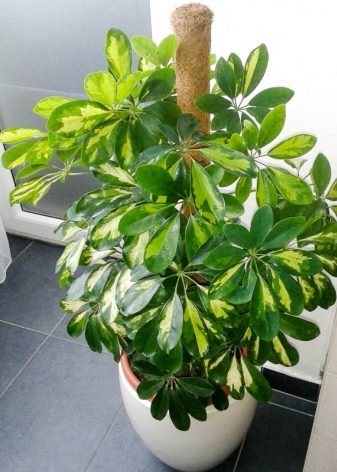

Scheffler (schefflera): care, types
Named after the German biologist Jacob Scheffler, the representatives of the Aralievs are shrubs, tree-like and vines, reaching various lengths in natural conditions (from 1.5 to 40 meters). All of them have characteristic complex leaves, dissected into 4-12 lobes and resembling a palm with spread fingers. Sheffler is also called the umbrella tree. In the wild, the plant blooms beautifully and bears fruit, but as a room culture, it pleases the eye only with generous magnificent greens.
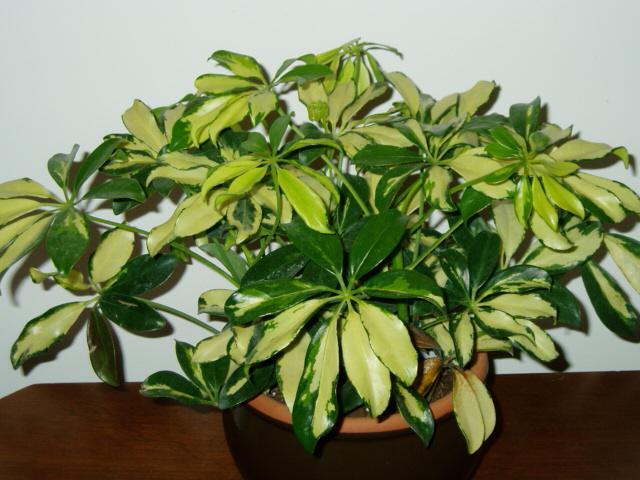

The genus has up to 200 species. Among them, radiant or star-shaped sheffler is used for growing at home. The origin of the plant dictates the conditions of care and maintenance common to all types. Sometimes the sheflera sheds the leaves. What to do in this case, let's try to figure it out further.
Gallery: Scheffler's flower (25 photos)
Photo
The photo shows Scheffler with proper home care:
For those who grow sheffler, articles about plant care, as well as breeding methods, may be useful.
How to transplant to the chefler
Transplanting chefs at home is a simple matter.
The flower chefler needs to be transplanted only once every 2-3 years. The best seasons for this process would be spring or fall. A transplant can be done more often only when you see that the plant is capable of very fast growth and reaches a decent height. The choice of a pot plays a big role, it is better to let it be large and voluminous, it will give the flower the opportunity for rapid growth. A pot with holes is an ideal choice, this is necessary so that when watering, excess water flows into the pan.
Transplant chiefs
As the plant grows, it becomes necessary to transplant. Like most indoor plants, the chefler requires an increase in the area of the container: once a year for a young flower, and subsequently, in an adult state, every few years.
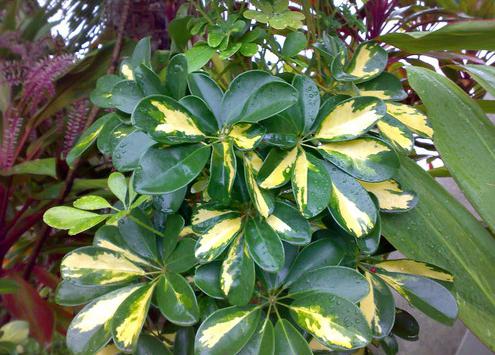

The correct selection of soil is also extremely important: it must be water and air permeable, so that in case of waterlogging, stagnation of water does not form and negative consequences arise.Gardening shops offer a versatile potting soil that works well for shefflers. The bottom of the container must be covered with a thick layer of any drainage material.
[collapse]

